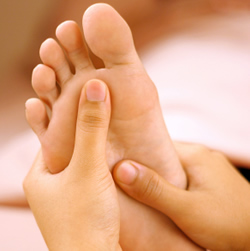Babies are often born with flat feet, which may persist well into their childhood. This occurs because children’s bones and joints are flexible, causing their feet to flatten when they stand. Young babies also have a fat pad on the inner border of their feet that hides the arch. You still can see the arch if you lift your baby up on the tips of the toes, but it disappears when he’s standing normally.
Most flat feet are caused by loose joint connections and baby fat between the foot bones. These conditions make the arch fall when your child stands up. This is why you sometimes hear flat feet called "fallen arches." The feet may look like they have arches when your child is sitting or when the big toe is bent backward, but the arch flattens when the child puts weight on the foot.
Symptoms that should be checked by a pediatrician include foot pain, sores or pressure areas on the inner side of the foot, a stiff foot, limited side-to-side foot motion, or limited up-and-down ankle motion. For further treatment you should see a pediatric orthopedic surgeon experienced in childhood foot conditions.
Will some activities make flat feet worse?
No. You don't need to limit your child's activities. If flat feet become painful from overuse, your doctor may recommend rest. Wearing a certain style of shoe, walking barefoot, running, doing foot exercises or jumping will not make flat feet worse or better.

Your Baby checkup
what are the vaccinations that he should have taken until now?
Generate a report for my baby.
Track Your Baby Vaccinations
Find Your Baby name
Mohandessin
01002195777
01000012400
0233048350
Beverly Hills
01000012900
0238576831
El Tagamo3
Al Sheikh Zayed
02- 38514031
01000608597


